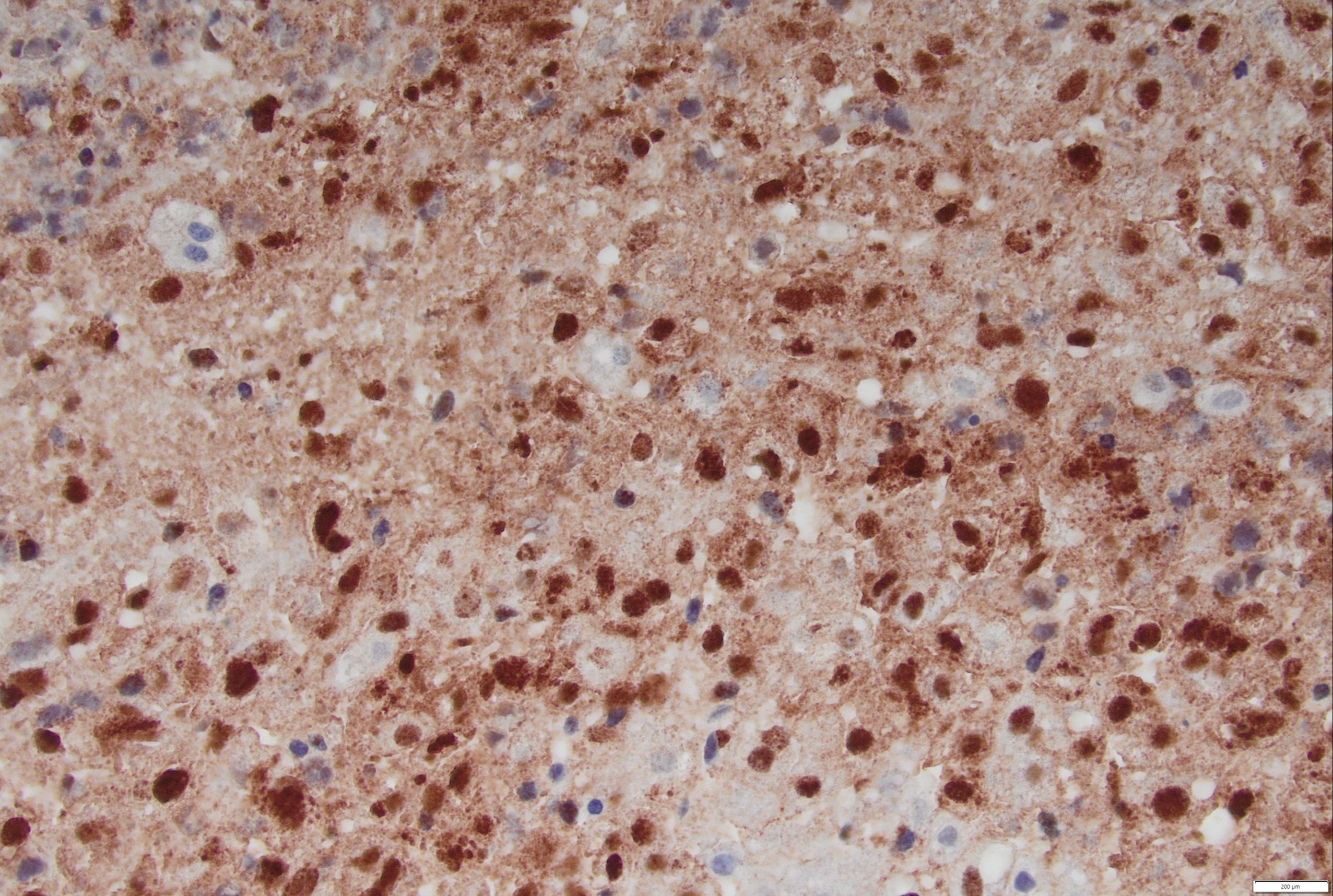Tuesday Poster Session
Category: Liver
P3885 - Fulminant Hepatic Failure Secondary to Herpes Simplex Virus in a Patient with Systemic Lupus Erythematosus and a Gout Flare: A Postmortem Diagnosis
Tuesday, October 24, 2023
10:30 AM - 4:00 PM PT
Location: Exhibit Hall

Has Audio
- MM
Matthew T. Moran, MD
Albert Einstein Medical Center
Philadelphia, PA
Presenting Author(s)
Nandakumar Mohan, DO, Nino Gudushauri, MD, Prutha Shah, DO, Alexander Prendergast, DO, Matthew Moran, MD, Robert Dejoy, DO, Lucas Angelim, MD, Tommy Nguyen, DO, Olubunmi Shoyele, MD
Albert Einstein Medical Center, Philadelphia, PA
Introduction: Fulminant liver failure secondary to herpes simplex virus (HSV) is extremely rare accounting for approximately 1% of cases. Timely diagnosis is challenging given the nonspecific presentation and rapid deterioration leading to high fatality rate. This case adds to the scarce literature by presenting hyperacute liver failure in a 49-year-old female with acute gout flare and systemic lupus erythematosus (SLE).
Case Description/Methods: We present a 49-year-old female with a medical history of SLE on chronic prednisone and hydroxychloroquine, gout, and atrial fibrillation not on anticoagulation who presented for transient hypotension that resolved spontaneously and anemia requiring blood transfusion. While initially, she was treated for a presumed gout flare with increased prednisone dose of 20mg daily, her next two days of hospital course was complicated by intermittent fevers resolving with acetaminophen, which was primarily attributed to febrile nonhemolytic transfusion reaction. On day 4, the patient reported severe abdominal pain with markedly elevated AST of 643 IU/L and ALT of 2111 IU/L with marked lactic acidosis >10mmol/L. CTA at that time was negative for any intraabdominal process.
In the evening patient became unresponsive and developed anicteric transaminitis, disseminated intravascular coagulopathy and multiorgan failure. The patient went into PEA arrest 4 times within the next 24 hours and passed away. Autopsy showed diffuse hemorrhagic necrosis with viral cytopathic effect and immunostaining diffusely positive for HSV, giving a postmortem diagnosis of Fulminant HSV Hepatitis.
Discussion: HSV induced fulminant hepatitis most commonly presents with fever, anicteric transaminitis, multiorgan failure, and most importantly is often a postmortem diagnosis due to delay in recognition.1 Herpetic rash is seen in less than 50% of cases. Fever in our patient was confounded by the gout flare and blood transfusion. Considering the patient’s SLE and rapid deterioration within 24 hours, presumption was made that cause of death was catastrophic antiphospholipid antibody syndrome leading to multiorgan failure. While our patient had rapid clinical deterioration unlikely to resolve from medical intervention, it is crucially important to have high level of clinical suspicion for HSV hepatitis in immunocompromised patient as early recognition and treatment with acyclovir or liver transplantation significantly improves survival.

Disclosures:
Nandakumar Mohan, DO, Nino Gudushauri, MD, Prutha Shah, DO, Alexander Prendergast, DO, Matthew Moran, MD, Robert Dejoy, DO, Lucas Angelim, MD, Tommy Nguyen, DO, Olubunmi Shoyele, MD. P3885 - Fulminant Hepatic Failure Secondary to Herpes Simplex Virus in a Patient with Systemic Lupus Erythematosus and a Gout Flare: A Postmortem Diagnosis, ACG 2023 Annual Scientific Meeting Abstracts. Vancouver, BC, Canada: American College of Gastroenterology.
Albert Einstein Medical Center, Philadelphia, PA
Introduction: Fulminant liver failure secondary to herpes simplex virus (HSV) is extremely rare accounting for approximately 1% of cases. Timely diagnosis is challenging given the nonspecific presentation and rapid deterioration leading to high fatality rate. This case adds to the scarce literature by presenting hyperacute liver failure in a 49-year-old female with acute gout flare and systemic lupus erythematosus (SLE).
Case Description/Methods: We present a 49-year-old female with a medical history of SLE on chronic prednisone and hydroxychloroquine, gout, and atrial fibrillation not on anticoagulation who presented for transient hypotension that resolved spontaneously and anemia requiring blood transfusion. While initially, she was treated for a presumed gout flare with increased prednisone dose of 20mg daily, her next two days of hospital course was complicated by intermittent fevers resolving with acetaminophen, which was primarily attributed to febrile nonhemolytic transfusion reaction. On day 4, the patient reported severe abdominal pain with markedly elevated AST of 643 IU/L and ALT of 2111 IU/L with marked lactic acidosis >10mmol/L. CTA at that time was negative for any intraabdominal process.
In the evening patient became unresponsive and developed anicteric transaminitis, disseminated intravascular coagulopathy and multiorgan failure. The patient went into PEA arrest 4 times within the next 24 hours and passed away. Autopsy showed diffuse hemorrhagic necrosis with viral cytopathic effect and immunostaining diffusely positive for HSV, giving a postmortem diagnosis of Fulminant HSV Hepatitis.
Discussion: HSV induced fulminant hepatitis most commonly presents with fever, anicteric transaminitis, multiorgan failure, and most importantly is often a postmortem diagnosis due to delay in recognition.1 Herpetic rash is seen in less than 50% of cases. Fever in our patient was confounded by the gout flare and blood transfusion. Considering the patient’s SLE and rapid deterioration within 24 hours, presumption was made that cause of death was catastrophic antiphospholipid antibody syndrome leading to multiorgan failure. While our patient had rapid clinical deterioration unlikely to resolve from medical intervention, it is crucially important to have high level of clinical suspicion for HSV hepatitis in immunocompromised patient as early recognition and treatment with acyclovir or liver transplantation significantly improves survival.

Figure: c. Immunohistochemical stain for HSV1/2 (IHC stain 40X)
Disclosures:
Nandakumar Mohan indicated no relevant financial relationships.
Nino Gudushauri indicated no relevant financial relationships.
Prutha Shah indicated no relevant financial relationships.
Alexander Prendergast indicated no relevant financial relationships.
Matthew Moran indicated no relevant financial relationships.
Robert Dejoy indicated no relevant financial relationships.
Lucas Angelim indicated no relevant financial relationships.
Tommy Nguyen indicated no relevant financial relationships.
Olubunmi Shoyele indicated no relevant financial relationships.
Nandakumar Mohan, DO, Nino Gudushauri, MD, Prutha Shah, DO, Alexander Prendergast, DO, Matthew Moran, MD, Robert Dejoy, DO, Lucas Angelim, MD, Tommy Nguyen, DO, Olubunmi Shoyele, MD. P3885 - Fulminant Hepatic Failure Secondary to Herpes Simplex Virus in a Patient with Systemic Lupus Erythematosus and a Gout Flare: A Postmortem Diagnosis, ACG 2023 Annual Scientific Meeting Abstracts. Vancouver, BC, Canada: American College of Gastroenterology.
